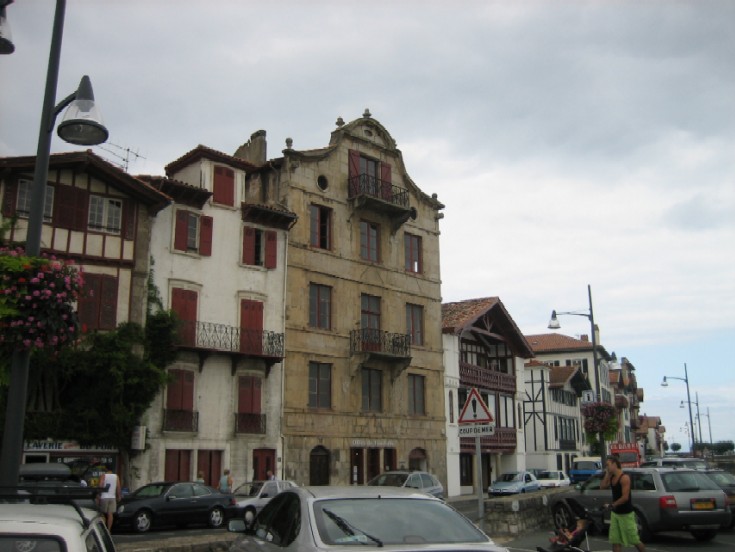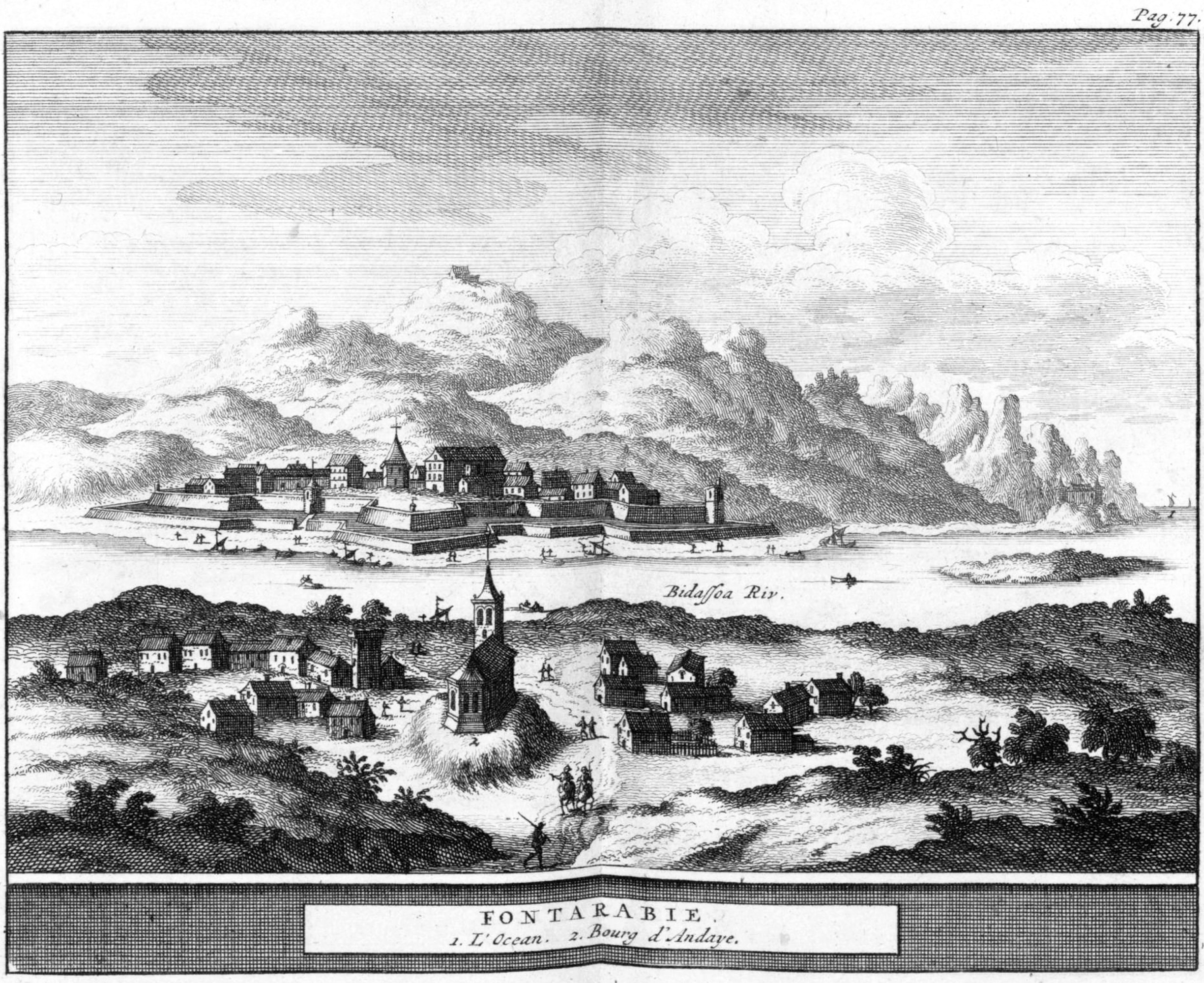|
Laburdi
Labourd ( eu, Lapurdi; la, Lapurdum; Gascon: ''Labord'') is a former French province and part of the present-day Pyrénées Atlantiques ''département''. It is one of the traditional Basque provinces, and identified as one of the territorial component parts of the Basque Country by many, especially by the Basque nationalists. Labourd extends from the Pyrenees to the river Adour, along the Bay of Biscay. To the south is Gipuzkoa and Navarre in Spain, to the east is Basse-Navarre, to the north are the Landes. It has an area of almost and a population of over 200,000 (115,154 in 1901; 209,913 in 1990), the most populous of the three French Basque provinces. Over 25% of the inhabitants speak Basque (17% in the Bayonne-Anglet-Biarritz zone, 43% in the rest). Labourd has also long had a Gascon-speaking tradition, noticeably next to the banks of the river Adour but also more diffusely throughout the whole viscounty (about 20% in Bayonne-Anglet-Biarritz). The main town of Labour ... [...More Info...] [...Related Items...] OR: [Wikipedia] [Google] [Baidu] |
Pyrénées-Atlantiques
Pyrénées-Atlantiques (; Gascon Occitan: ''Pirenèus Atlantics''; eu, Pirinio Atlantiarrak or ) is a department in the southwest corner of France and of the region of Nouvelle-Aquitaine. Named after the Pyrenees mountain range and the Atlantic Ocean, it covers the French Basque Country and the Béarn. Its prefecture is Pau. In 2019, it had a population of 682,621.Populations légales 2019: 64 Pyrénées-Atlantiques INSEE History Originally named Basses-Pyrénées, it is one of the first 83 created during the |
Landes Forest
The Landes forest (; La forêt des Landes in French) in the Landes de Gascogne (las Lanas de Gasconha in the Gascon language), in the historic Gascony natural region of southwestern France now known as Aquitaine, is the largest man-made woodland in Western Europe. The French word, ''landes'' and Gascon ''lanas'', mean 'moors' or 'heaths', from Transalpine Gaulish *''landa'' ("uninhabited/uncultivated area"); compare Irish ''lann'', Welsh ''llan'' (“enclosure”). Geography The forest (also known as the 'moors of Gascony', and formerly, the 'moors of Bordeaux') covers a large portion of Landes and Gironde, two of the departments of France; it also spills over into parts of the Lot-et-Garonne department. The sources of several rivers can be found in this region, including the sources of the Leyre, the Boudigau, the Ciron, and the Gat Mort. The largest towns within the forest are Arcachon, Dax, and Mont-de-Marsan. Origin as a pine plantation The forest is composed mostly of m ... [...More Info...] [...Related Items...] OR: [Wikipedia] [Google] [Baidu] |
Cyrano De Bergerac (play)
''Cyrano de Bergerac'' is a play written in 1897 by Edmond Rostand. There was a real Cyrano de Bergerac, and the play is a fictionalisation following the broad outlines of his life. The entire play is written in verse, in rhyming couplets of twelve syllables per line, very close to the classical alexandrine form, but the verses sometimes lack a caesura. It is also meticulously researched, down to the names of the members of the Académie française and the ''dames précieuses'' glimpsed before the performance in the first scene. The play has been translated and performed many times, and it is responsible for introducing the word ''panache'' into the English language. The character of Cyrano himself makes reference to "my panache" in the play. The most famous English translations are those by Brian Hooker, Anthony Burgess, and Louis Untermeyer. Plot summary Hercule Savinien de Cyrano de Bergerac, a cadet (nobleman serving as a soldier) in the French Army, is a brash, strong ... [...More Info...] [...Related Items...] OR: [Wikipedia] [Google] [Baidu] |
Cambo-les-Bains
Cambo-les-Bains (; eu, Kanbo) is a town in the traditional Basque province of Labourd, now in the Pyrénées-Atlantiques department in south-western France. It lies on the south-western bank of the river Nive. Cambo-les-Bains station has rail connections to Saint-Jean-Pied-de-Port and Bayonne. Population People In 1900, Edmond Rostand, writer of the play ''Cyrano de Bergerac'', came to Cambo-les-Bains because of his pulmonary disease. He was taken by the area and in time bought some land and had a house built. It was completed in 1906. His house, the Villa Arnaga, is now a heritage site and a museum devoted to Rostand's life and Basque architecture and crafts. The Spanish composer Isaac Albéniz died in Cambo-les-Bains in 1909 as well as another significant Spanish composer, Sebastián Durón, who died there in 1716. The French orientalist Jean Sauvaget died in Cambo in 1950. Musical instrument inventor Georges Jenny, who devised the Ondioline, died in Cambo-les-Bains in 19 ... [...More Info...] [...Related Items...] OR: [Wikipedia] [Google] [Baidu] |
Edmond Rostand
Edmond Eugène Alexis Rostand (, , ; 1 April 1868 – 2 December 1918) was a French poet and dramatist. He is associated with neo-romanticism and is known best for his 1897 play ''Cyrano de Bergerac''. Rostand's romantic plays contrasted with the naturalistic theatre popular during the late nineteenth century. Another of Rostand's works, ''Les Romanesques'' (1894), was adapted to the 1960 musical comedy ''The Fantasticks''. Early life Rostand was born in Marseille, France, into a wealthy and cultured Provençal family. His father was an economist, a poet who translated and edited the works of Catullus, and a member of the Marseille Academy and the Institut de France. Rostand studied literature, history, and philosophy at the Collège Stanislas in Paris, France. Career When Rostand was twenty years old, his first play, a one-act comedy, ''Le Gant rouge'', was performed at the Cluny Theatre, 24 August 1888, but it was almost unnoticed. [...More Info...] [...Related Items...] OR: [Wikipedia] [Google] [Baidu] |
La Rhune
Larrun (modern French: ''La Rhune'', IPA: a'run - 'good pasture', possibly a folk etymology, in French until the 20th century: ''Larhune'' ) is a mountain (905 m) at the western end of the Pyrenees. It is located on the border of France and Spain, where the traditional Basque provinces of Labourd and Navarra meet. Its prominence is 670 m. History Larrun holds an iconic place in Basque culture. It is covered in dolmens, stone circles and other neolithic monuments and was held to be a sacred place in Basque mythology. It was said to be the home of Lehensugea, the first serpent. Later, and perhaps as a consequence of the ancient sacred sites, the summit had a reputation as an '' akelarre'' or ritual meeting place for witches. Up until the 18th century, local villages paid for a monk to live as a hermit at the top of the mountain to keep witches away and ensure good winds. The mountain was used by French troops as a defensive position towards the end of the Peninsular War, but Well ... [...More Info...] [...Related Items...] OR: [Wikipedia] [Google] [Baidu] |
Espelette
Espelette (; ; oc, Espeleta) is a commune in the Pyrénées-Atlantiques department in south-western France. It lies in the traditional Basque province of Labourd. Sights The town is attractive, with traditional Labourd houses and a castle. The protected sixteenth-century church, Saint-Etienne, has a Baroque altarpiece, and its graveyard has many traditional Basque discoidal tombstones. Notable people * Agnès Souret, the first woman ever chosen as Miss France, in 1920, is buried in Espelette. She died in Argentina, aged 26, in 1928, and her body was repatriated to Espelette by her mother, who sold most of her possessions to provide a resting place for her daughter. * Father Armand David (1826–1900), a Lazarist missionary Catholic priest as well as a zoologist and a botanist, was born in Espelette. Red peppers Espelette is known for its dried red peppers, used whole or ground to a hot powder, used in the production of Bayonne ham. The peppers are designated as Appellation d ... [...More Info...] [...Related Items...] OR: [Wikipedia] [Google] [Baidu] |
Fêtes De Bayonne
The fêtes de Bayonne is a feria consisting in a series of festivals in the Northern Basque Country in the town of Bayonne, France. The festival lasts 5 days and always starts the Wednesday before the first Sunday of August. It is the largest festival in France. In the eighties, participants started to dress in white with a red scarf and a red belt after the colours of the city of Pamplona. Some rare purists prefer to wear blue and white, the colours of the city of Bayonne. The festivals include musical and street performances, traditional dances, parades, and fireworks. The first "Fêtes de Bayonne," called "The Big Summer Festival," took place on July 13, 1932. It was instigated by a group of friends belonging to the Aviron Bayonnais rugby team. They wanted to create celebrations similar to those of San Fermin in Pamplona, Spain (famous for their Running of the Bulls A running of the bulls ( es, encierro, from the verb ''encerrar'', 'to corral, to enclose'; oc, abrivad ... [...More Info...] [...Related Items...] OR: [Wikipedia] [Google] [Baidu] |
Hasparren
Hasparren (; eu, Hazparne) is a commune in the Pyrénées-Atlantiques department in south-western France. A resident of Hasparren is known as a 'Hazpandar'. Geography Location It's a ''commune fait partie'' of the Basque Province of Labourd. The Côte Basque (''Euskal Kostaldea)'', is 25 km to the west. Access Hasparren is located on the route D 10, between La Bastide-Clairence and Cambo-les-Bains, at the crossroads with D 21, D 22 and D 23. It has got access to autoroute A 64, exit 4 near Briscous. Hydrography The rivers Ardanabia and Suhihandia (a tributary of the Aran), flow through the commune. Locations Eight settlements compose the Commune of Hasparren: * Labiri ; * Elizaberri ; * la Coste (la Côte sur les cartes IGN) ; * Peña (Pegna sur les cartes IGN) ; * Minhotz ; * la Ville ; * Urcuray ; * Bas-Labiri et Zelhaia . Toponymy Ancient attestations It is attestested with various words: ''Hesperenne'' (1247 in Cartulaire de Bayonne) ''Sant ... [...More Info...] [...Related Items...] OR: [Wikipedia] [Google] [Baidu] |
Saint-Jean-de-Luz
Saint-Jean-de-Luz (; eu, Donibane Lohitzune,Donibane Lohitzune Auñamendi Encyclopedia, Auñamendi Eusko Entziklopedia es, San Juan de Luz, oc, Sent Joan de Lus, ) is a communes of France, commune in the Pyrénées-Atlantiques Departments of France, department, southwestern France. Saint-Jean-de-Luz is part of the Basque Country (greater region), Basque province of Labourd (Lapurdi). Geography Saint-Jean-de-Luz is a fishing port on the Basque coast and now a famous resort, known for its architecture, sandy bay, the quality of the light and the cuisine. The town is located south of Biarritz, on the right bank of the river Nivelle (river), Nivelle (French language, French for Urdazuri) opposite to Ciboure. The port lies on the estuary just before the river joins the ocean. ...[...More Info...] [...Related Items...] OR: [Wikipedia] [Google] [Baidu] |
Ciboure
Ciboure (; ,ZIBURU meaning 'end of bridge') is a in the department in south-western . It lies across the river |
Hendaye
Hendaye (Basque language, Basque: ''Hendaia'')HENDAIA Auñamendi Encyclopedia, Auñamendi Eusko Entziklopedia is a Communes of France, commune in the Pyrénées-Atlantiques Departments of France, department and Nouvelle-Aquitaine Regions of France, region of southwestern France.INSEE commune file /ref> The town, Metropolitan France's most southwesterly and a popular seaside tourist resort, stands on the right bank of the Bidassoa, River Bidassoa – which marks the France–Spain border, Franco-Spanish border – at the point where it empties into the Atlantic Ocean in the Northern Basque Country, French Basque Country. Hendaye has three distinguishable parts: ''la ville' ... [...More Info...] [...Related Items...] OR: [Wikipedia] [Google] [Baidu] |





